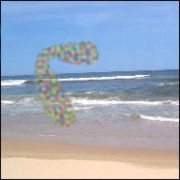| Scintillating scotoma | |
|---|---|
| Other names | Visual migraine[1] Teichopsia[2] |
 | |
| Example of a scintillating scotoma, as may be caused by cortical spreading depression | |
| Specialty | Neurology, Neuro-ophthalmology |
| Symptoms | Aura in vision, nausea, dizziness, brain fog |
| Complications | Migraine onset |
| Duration | Less than 60 minutes[3] |
| Causes | Cortical spreading depression |
| Risk factors | Migraine sufferer |
| Differential diagnosis | Persistent aura without infarction, Retinal migraine |
| Prevention | Avoiding migraine triggers |
| Prognosis | Self-limiting |

Scintillating scotoma is a common visual aura that was first described by 19th-century physician Hubert Airy (1838–1903). Originating from the brain, it may precede a migraine headache, but can also occur acephalgically (without headache), also known as visual migraine or migraine aura.[4] It is often confused with retinal migraine, which originates in the eyeball or socket.
- ^ Prasad, Sashank. "Visual Migraine" (PDF). Brigham and Women's Hospital. Harvard Medical School. Archived from the original (PDF) on 18 March 2015. Retrieved 4 October 2016.
- ^ "teichopsia". Concise Medical Dictionary (8th ed.). Oxford University Press. 2010. doi:10.1093/acref/9780199557141.001.0001. ISBN 9780199557141. Retrieved 15 December 2020 – via oxfordreference.com.
- ^ Cite error: The named reference
imigrainewas invoked but never defined (see the help page). - ^ Lee, Ann (11 July 2022). "'It starts as a line of light, then works its way across my vision': the disorienting mystery of migraine auras". The Guardian.